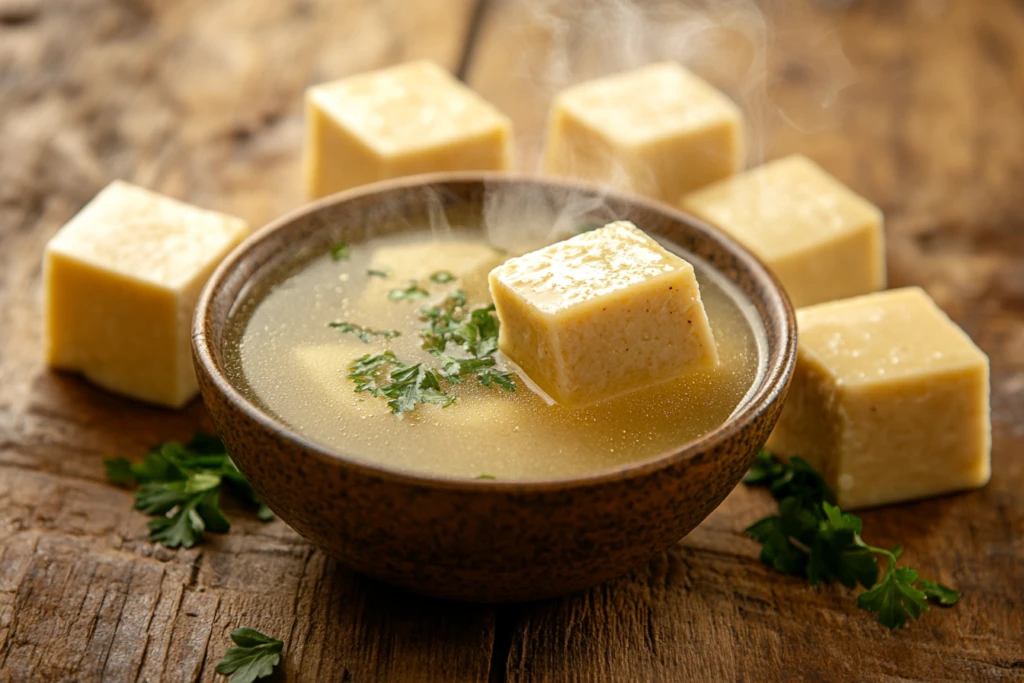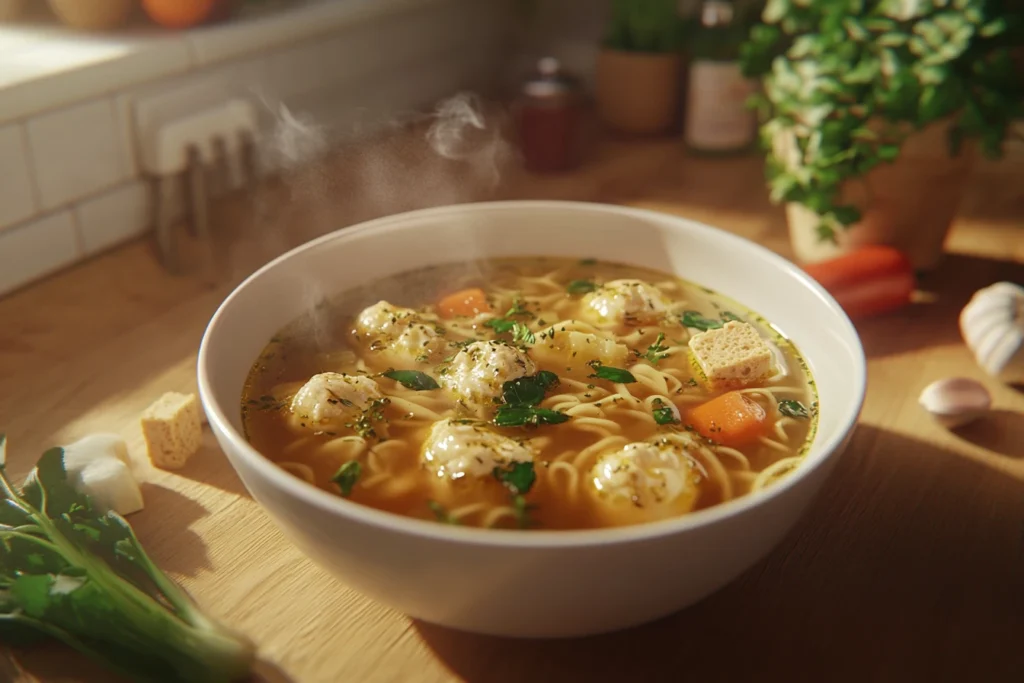1. Introduction to Chicken Bouillon
Chicken bouillon is a versatile kitchen staple used worldwide for enhancing the flavor of soups, stews, sauces, and grains. Whether you’re preparing a quick broth or enriching a hearty dish, chicken bouillon delivers a savory taste that elevates recipes.
Available in various forms, including cubes, powders, and pastes, it is easy to store and prepare, making it an ideal choice for home cooks and chefs.
This article explores the origins, nutritional value, health benefits, and practical uses of chicken bouillon. Additionally, it provides recipes, substitutes, and storage tips, helping readers understand how to maximize its flavor and utility in the kitchen.
2. What Is Chicken Bouillon?
Chicken bouillon is essentially dehydrated chicken broth or stock, made by concentrating chicken essence, seasonings, and fats into a solid or powdered form. It serves as a convenient alternative to homemade chicken broth while preserving a rich, savory flavor.
2.1 Definition and Composition
Chicken bouillon combines dehydrated chicken stock, vegetable extracts, salt, herbs, and spices. Many commercial versions also include MSG (monosodium glutamate) to enhance umami flavors.
Key Ingredients:
- Chicken Essence or Extracts: Provides the base flavor.
- Salt and Seasonings: Adds taste and preservation.
- Vegetable Powders: Includes onions, garlic, and carrots for depth.
- Fat or Oil: Improves texture and richness.
- Preservatives and MSG: Enhances flavor and shelf life.
2.2 Types of Chicken Bouillon

Chicken bouillon comes in several forms, each offering unique benefits based on cooking methods and storage preferences.
2.2.1 Cubes
- Compact and pre-measured for single servings.
- Easily dissolves in hot water to make instant broth.
- Ideal for traveling and emergency food kits.
2.2.2 Powders
- Quick-dissolving for instant flavor enhancements.
- Allows for flexible portioning to suit recipes.
- Works well as a dry rub for meat seasoning.
2.2.3 Pastes
- Provides rich, concentrated flavor.
- Best suited for slow-cooked dishes and sauces.
- Typically requires refrigeration after opening.
2.2.4 Homemade Bouillon
- Made with fresh ingredients and without preservatives. (Check out this homemade bouillon recipe for a healthier option.)
- Customizable to fit dietary needs such as low-sodium or organic.
3. Nutritional Value of Chicken Bouillon
Chicken bouillon is widely appreciated for its convenience and flavor, but it’s important to examine its nutritional profile to understand its health implications. While it’s low in calories, it may also contain high sodium levels and artificial additives, depending on the variety.
3.1 Macronutrient Breakdown
Chicken bouillon is typically low in calories, making it a suitable addition to low-calorie diets. However, it contributes minimal macronutrients such as protein, fats, and carbohydrates.
Typical Nutritional Content Per Serving (1 Cube or 1 Teaspoon Powder):
- Calories: 10–15 kcal
- Protein: Less than 1 gram
- Fat: 0.5 grams or less
- Carbohydrates: 1–2 grams
- Sodium: 600–800 mg (depending on the brand)
This low-calorie profile makes it ideal for weight management plans or detox diets. (Learn more about its nutritional properties in this Healthline article.)
3.2 Micronutrients and Additives
While commercial version is not a significant source of vitamins and minerals, it often contains trace amounts of potassium, magnesium, and B vitamins.
Key Micronutrients:
- Potassium: Supports muscle function and nerve signaling.
- Magnesium: Helps maintain energy production.
- Niacin (Vitamin B3): Improves metabolism and digestion.
Potential Additives in Commercial Bouillon:
- Monosodium Glutamate (MSG): Enhances flavor but may cause sensitivities in some people.
- Artificial Preservatives: Increase shelf life but may contain sodium-heavy compounds.
- Colorants and Flavor Enhancers: Provide visual appeal and richer flavors but may lack natural ingredients.
3.3 Dietary Considerations
Chicken bouillon can fit into low-carb, keto, and gluten-free diets, but some versions contain added starches or sugars. For those seeking cleaner alternatives, homemade or organic bouillons are better options.
Quick Tip: Opt for low-sodium and preservative-free brands to maintain heart health. (For more insights, explore WebMD’s guide on sodium effects.)
4. Health Benefits and Risks of Chicken Bouillon
Chicken bouillon is a convenient and flavorful ingredient often used in cooking, but it’s essential to evaluate its health benefits and potential risks. While it provides hydration and flavor enhancement, it may also pose concerns for sodium intake and additives.
4.1 Health Benefits of Chicken Bouillon
4.1.1 Hydration and Electrolyte Balance
Chicken bouillon, when dissolved in water, becomes a hydrating liquid that can help replenish electrolytes. Its sodium content is beneficial for rehydration after illness, dehydration, or workouts.
4.1.2 Digestive Comfort
Due to its light and soothing texture, chicken bouillon is often consumed when recovering from illness or upset stomachs. It’s easy to digest and provides comforting warmth.
4.1.3 Detox Support and Low-Calorie Benefits
Chicken bouillon is a common ingredient in detox diets due to its low calorie and hydrating properties. It acts as a flavorful base while keeping calorie intake low during cleanses. (Find more detox recipes in this detox broth guide.)
4.1.4 Enhances Flavor Without Extra Calories
As a calorie-conscious ingredient, chicken bouillon enhances flavors without added fats or carbohydrates. It is often preferred in weight-loss meal plans to boost taste and satiety.
4.2 Potential Risks of Chicken Bouillon
4.2.1 High Sodium Content
One of the main concerns with chicken bouillon is its high sodium level, which can contribute to:
- High blood pressure (hypertension).
- Water retention and bloating.
- Increased risk of heart disease with long-term excessive consumption.
Tip: Opt for low-sodium or no-salt-added versions to reduce sodium intake.
4.2.2 MSG Sensitivity
Many commercial chicken bouillons contain monosodium glutamate (MSG) to enhance flavor. While safe for most people, some may experience:
- Headaches or dizziness.
- Nausea or fatigue.
Those sensitive to MSG should read labels carefully or choose homemade bouillon options.
4.2.3 Limited Nutritional Value
Although chicken bouillon is flavorful, it lacks essential nutrients like protein, fiber, and vitamins. It’s best used as a base ingredient rather than a standalone meal. (For a more nutrient-dense option, explore the health benefits of black chicken as a rich source of protein and antioxidants.)
4.3 Healthier Alternatives to Chicken Bouillon
For those seeking healthier options, alternatives include:
- Low-Sodium Formula: Preserves flavor while reducing sodium intake.
- Homemade Recipe: Allows custom seasoning and fresh ingredients. (Check out this homemade bouillon recipe for a healthier version.)
- Vegetable Bouillon: Suitable for vegetarians and vegan diets.
- Bone Broth: Offers higher protein and collagen content for joint health.
5. Culinary Uses of Chicken Bouillon
Chicken bouillon is widely used in home kitchens and professional cooking for its ability to add rich flavor and depth to a variety of dishes. Its versatility allows it to be used in soups, stews, sauces, and even grain dishes.
5.1 Chicken Bouillon in Soups and Stews

Chicken bouillon serves as the foundation for many soups and stews, offering a savory and hearty base.
Examples of Recipes Using Chicken Bouillon:
- Classic Chicken Noodle Soup: Dissolve a cube or teaspoon into boiling water, then add shredded chicken, vegetables, and noodles.
- Vegetable Stew: Use bouillon to create a rich broth for vegetables and beans.
- Creamy Potato Soup: Add bouillon for flavorful depth without extra fat.
Pro Tip: Dissolving chicken bouillon powder into water allows for instant broth preparation, making it a quick and effective solution.
5.2 Enhancing Sauces and Gravies
Chicken bouillon can be incorporated into gravies, sauces, and marinades to boost flavor.
Ideas for Sauce Applications:
- Gravy Base: Dissolve bouillon in warm water, then add flour and butter for smooth and savory gravy.
- Pan Sauces: Deglaze pans with bouillon-infused water for a rich finish.
- Marinades: Combine bouillon with garlic, herbs, and lemon juice for marinating chicken or vegetables.
5.3 Cooking Grains with Chicken Bouillon
Using it to cook grains like rice, quinoa, or couscous imparts a delicious flavor while maintaining moisture and texture.
Step-by-Step for Rice with Chicken Bouillon:
- Dissolve 1 bouillon cube or 1 teaspoon powder in 2 cups of water.
- Add rice and seasonings and cook until tender.
- Finish with herbs and butter for added flavor.
Popular Dishes:
- Risottos: Creamy, flavor-packed rice dishes enhanced with bouillon.
- Pilafs: Fluffy rice mixed with vegetables and spices.
- Stuffed Peppers: Grains cooked in bouillon broth for a flavorful filling.
5.4 Marinades, Rubs, and Seasonings

Chicken bouillon works well as a dry rub or liquid marinade base for meats and vegetables. Combine bouillon powder, olive oil, lemon juice, and garlic for a flavorful marinade. (For more seasoning inspirations, try this perfect burger sauce recipe to complement your dishes.)
Marinade Example:
- Mix bouillon powder, olive oil, lemon juice, and garlic.
- Coat chicken and refrigerate for 1–2 hours before grilling.
Dry Rub Example:
- Combine bouillon powder, paprika, black pepper, and thyme.
- Rub onto meats before roasting or baking for enhanced flavor.
5.5 Vegan and Vegetarian Adaptations
While traditional chicken bouillon is not vegetarian, plant-based versions are available.
Vegetable Bouillon Alternatives:
- Made from dehydrated vegetables and herbs.
- Suitable for vegetarians and vegans looking for similar savory flavors. (Check out this vegetable bouillon recipe for plant-based options.)
Chicken bouillon’s adaptability makes it an essential ingredient in modern cooking. From soups and sauces to marinades and grains, its ability to enhance flavor effortlessly is unmatched.
6. Substitutes for Chicken Bouillon
While it is a convenient flavor enhancer, there are times when alternatives are needed, whether for dietary restrictions, health preferences, or simply running out of it in the pantry. Here are the best substitutes to maintain flavor without compromising the dish.
6.1 Chicken Broth or Stock
Chicken broth and stock are the closest alternatives to the formula. They are made from simmered chicken bones, meat, and vegetables, offering rich flavor and natural nutrients.
Key Benefits:
- Provides a fresh and natural taste.
- Rich in collagen (when homemade) and proteins.
- Suitable for soups, stews, and gravies.
Usage Tip: Replace 1 cube with 1 cup of chicken broth for similar flavor.
6.2 Vegetable Bouillon
For vegetarian and vegan diets, vegetable bouillon is an excellent alternative. Made with dried vegetables, herbs, and spices, it delivers savory flavor without using animal-based products.
Best Uses:
- Works well in soups, risottos, and vegetable-based dishes.
- Provides a low-fat and low-calorie option for clean eating plans.
6.3 Homemade Chicken Bouillon
Creating homemade recipe allows for custom seasoning and avoids preservatives.
Quick Recipe:
- Simmer chicken bones, carrots, celery, onions, and herbs in water for 2–3 hours.
- Strain and reduce the liquid until concentrated.
- Freeze into ice cube trays for easy use.
Benefits:
- Controls sodium levels.
- No MSG or artificial flavors.
- Freezable and long-lasting.
6.4 Bone Broth as a Nutrient-Rich Alternative
Bone broth is similar to chicken stock but is simmered for a longer duration, extracting collagen, amino acids, and minerals. It provides:
- Joint support through collagen.
- Better gut health from gelatin content.
- Higher protein content than traditional version.
Usage Tip: Replace 1 bouillon cube with ½ cup of bone broth for enhanced nutrition.
6.5 Herb-Based Seasoning Blends
If you’re out of chicken bouillon, you can create an herb seasoning blend to replicate its savory taste.
Suggested Mix:
- Garlic powder
- Onion powder
- Dried parsley
- Paprika
- Sea salt and pepper
Best Uses:
Sprinkle this blend into soups, grains, or meat marinades for natural flavor enhancement.
7. Frequently Asked Questions (FAQs)
7.1 What Exactly Is Chicken Bouillon?
It is a dehydrated form of chicken stock or broth, often available as cubes, powders, or pastes. It is made by combining chicken essence, salt, fats, and seasonings, making it a quick and flavorful option for cooking.
7.2 Is Chicken Stock and Bouillon the Same?
Not exactly. Chicken stock is made by simmering chicken bones, meat, and vegetables to create a fresh, liquid broth. In contrast, it is a concentrated, dehydrated version of stock designed for quick preparation. Both can be used interchangeably in most recipes.
7.3 Is Chicken Broth Good for You?
Yes, chicken broth provides hydration, electrolytes, and minerals such as potassium and magnesium. However, pre-packaged versions, including bouillon, may contain high sodium levels, so it’s essential to choose low-sodium options or homemade versions for better health benefits.
7.4 What Do Mexicans Call Chicken Bouillon?
In Mexican cuisine, it is commonly referred to as “caldo de pollo” or “consomé de pollo”. It is a popular base for soups, stews, and Mexican rice dishes, often paired with spices like cumin and cilantro for enhanced flavor.
8. Conclusion
Chicken bouillon is a versatile ingredient valued for its convenience and flavor-enhancing properties. Whether used in soups, sauces, marinades, or grain dishes, it provides a rich taste while being quick to prepare.
However, it’s important to consider its sodium content and additives when integrating it into your diet. Health-conscious consumers may prefer low-sodium options, organic varieties, or homemade alternatives for better nutrition and control.
From savory stews to flavorful marinades, chicken bouillon remains a staple in kitchens worldwide. Its affordability, versatility, and long shelf life make it a go-to ingredient for cooks of all levels.
